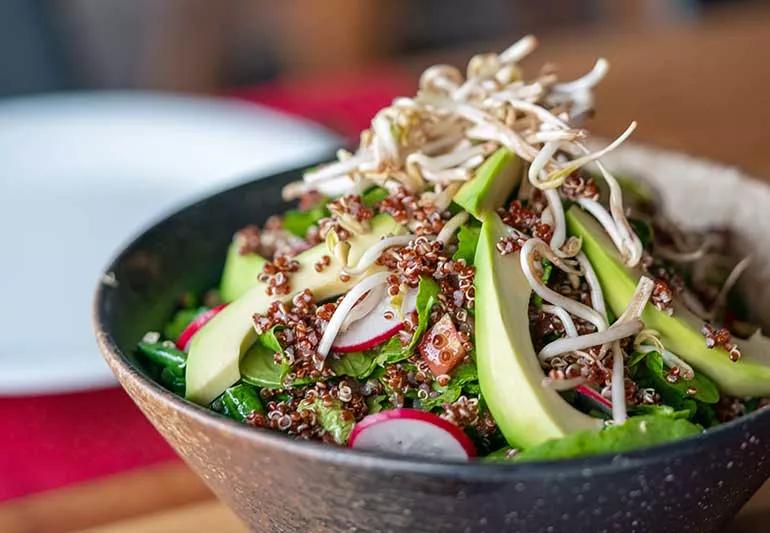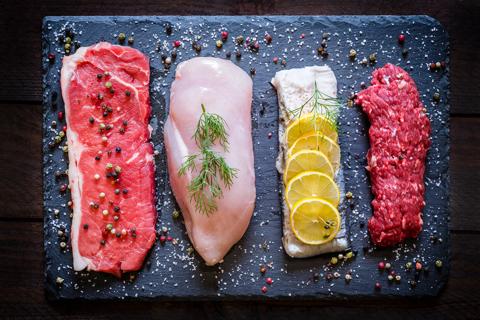Add fiber, watch the salt and reduce saturated fat in the meals you make

You want to eat healthier — and you’re focused on meals that not only taste good, but can also help keep your heart healthy.
Advertisement
Cleveland Clinic is a non-profit academic medical center. Advertising on our site helps support our mission. We do not endorse non-Cleveland Clinic products or services. Policy
And with good reason: More people die from heart disease in the United States than any other disease.
We’re here to help you on your journey to better heart health. Try one of these five easy, delicious heart-healthy lunch options from heart dietitian Kate Patton, RD, LD. Each one will give you the energy you need to tackle your afternoon.
Also, learn what makes a heart-healthy meal so you can make smart decisions when lunchtime arrives.
When deciding what to eat for lunch, how do you know if what you’re choosing is heart-healthy? Patton suggest following these tips:
Advertisement
Looking for some heart-healthy lunches to pack? Start with one of these five options:
Minestrone soup is typically made with veggies like onions, celery, carrots, cabbage and tomatoes, which are all full of good-for-you nutrients. This recipe also includes heart-healthy extra-virgin olive oil and legumes like kidney beans, which are a good source of fiber.
Drizzle a small amount of extra-virgin olive oil on top of each serving. Your meal can also include a small whole-grain baguette with side of extra-virgin olive oil and spices for dipping.
“Most of us eat too much animal protein and not enough plant protein,” explains Patton. “Choosing a bean-based soup a few days per week will greatly reduce intake of saturated fat and cholesterol and increase intake of soluble fiber.”
We all know salad is good for us, so it’s a no-brainer for a heart-healthy lunch.
Build your customized salad by starting with any kind of dark, leafy greens like arugula, kale or spinach. From there you can include your favorite vegetables like broccoli, Brussel sprouts, sweet potatoes or beets, which are all great heart-healthy options. Add some legumes or nuts for protein.
And the key to a heart-healthy salad? Making your own dressing of a simple mix of extra-virgin olive oil and vinegar.
You can also include a piece of fresh fruit as part of your meal.
“Salad is a good option because it keeps you full and satisfied. All the fiber, protein and healthy fats salads have will take quite some time to digest keeping you feeling full for hours,” notes Patton. “A salad with lots of texture will keep you chewing longer, allowing you to feel satisfied after eating for 15 minutes.”
If you’re craving a turkey club, you can satisfy that hankering while still making a heart-healthy meal that’s packed with protein.
Using a whole-grain wrap, layer low-sodium deli turkey or off-the-bone turkey, spinach and roasted red peppers. Before you roll it all up, add some extra-virgin olive oil, vinegar or hummus.
“If you’re on-the-go or don’t have a lot of time for lunch, a turkey wrap is quick and convenient,” says Patton. “It’s a balanced handheld meal that gives you complex carbohydrate, lean protein and healthy fat.”
This might not be the tuna sandwich you’re used to — one that’s loaded with mayo.
Instead, mix canned tuna with extra-virgin olive oil and red wine vinegar and sandwich in between two slices of sprouted grain bread. You’ll still have a flavorful sandwich that’s now better for you. Add a side salad to complete your meal.
Advertisement
“Tuna is rich in omega-3 fats. Omega-3 fat is a type of fat that has anti-inflammatory and heart-healthy benefits, but most of us don’t get enough,” explains Patton. “I say canned tuna is better than no tuna.”
Top a bed of greens like arugula or kale with 1 cup of cooked quinoa (or any grain you prefer like farro or barley).
Add your favorite flavors to your quinoa. For example, add salsa, corn, bell peppers and black beans or make a Greek quinoa salad with cucumber, tomato, red onion, feta and Greek dressing.
You can also eat a piece of fresh fruit.
“Grain bowls are a vessel to add so many healthy ingredients,” says Patton. “Choose a variety of colorful vegetables and herbs to maximize antioxidant benefits.”
While it can be tempting to head to a fast-food drive-thru or hit up the local deli near your office, with a little planning and organization you can set yourself up for success during lunchtime by making heart-healthy recipes. Your heart will thank you.
“Heart-healthy meals are not hard to make, but it does take some planning and awareness to pick the right foods,” says Patton.
Advertisement
Learn more about our editorial process.
Advertisement

With a focus on internal cues for hunger and fullness, this eating style may revolutionize your relationship with food

Review the ingredients, watch for sugar and fat, and choose one with the right amount of protein for your needs

A typical recommended balanced diet is half fruits and veggies, a quarter protein and a quarter grains

Foods high in protein, fiber and water can help keep hunger at bay

This quirky food trend is harmless, as long as you’re getting enough protein, fiber and healthy fats

This vital nutrient helps your brain and body in many ways — and most of us need more of it

Wrapped or sandwiched, try to choose fillings and condiments that are minimally processed, low in saturated fat and high in fiber

Set yourself up for success by carefully choosing your recipes, storage containers and prepping day

The best parenting style balances enforcing rules and showing plenty of love

Tips include cutting back on sugar, focusing on exercise and managing stress

It can be harder to let go when you’ve invested time, energy and emotions — but it might be the healthier choice long term